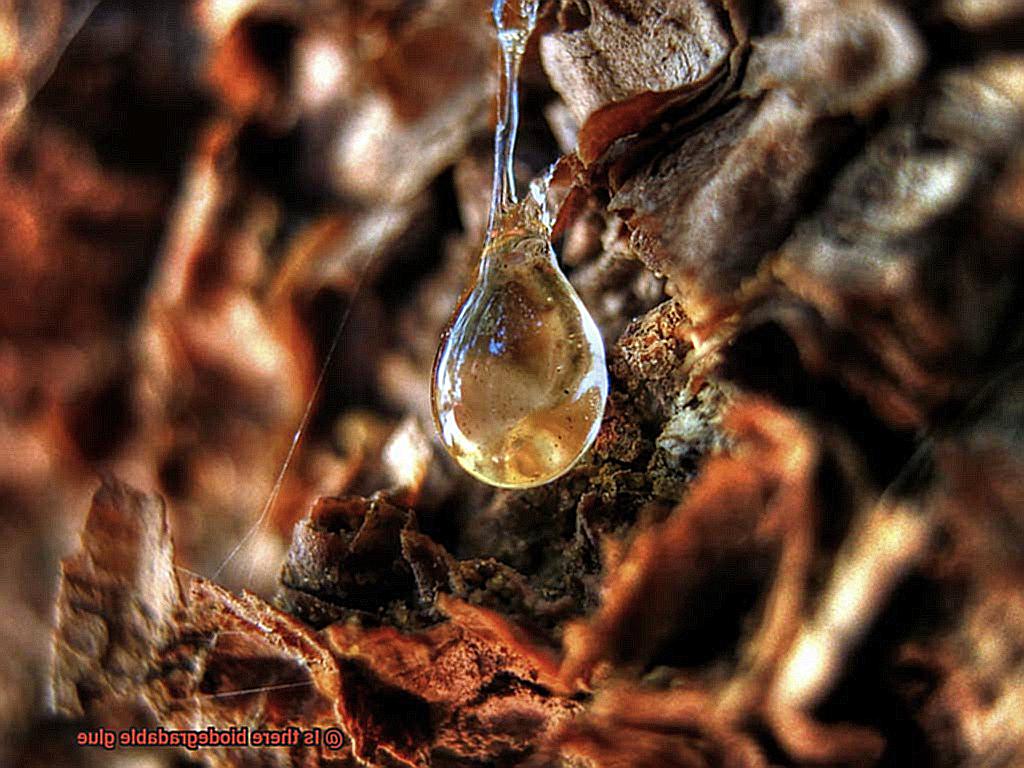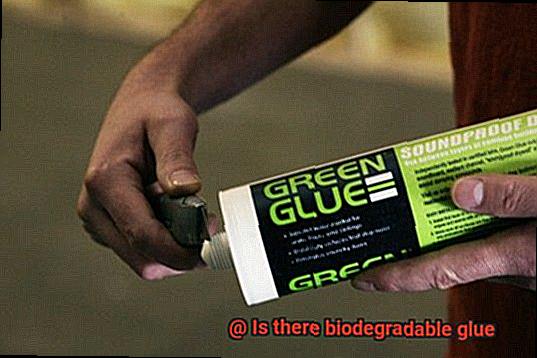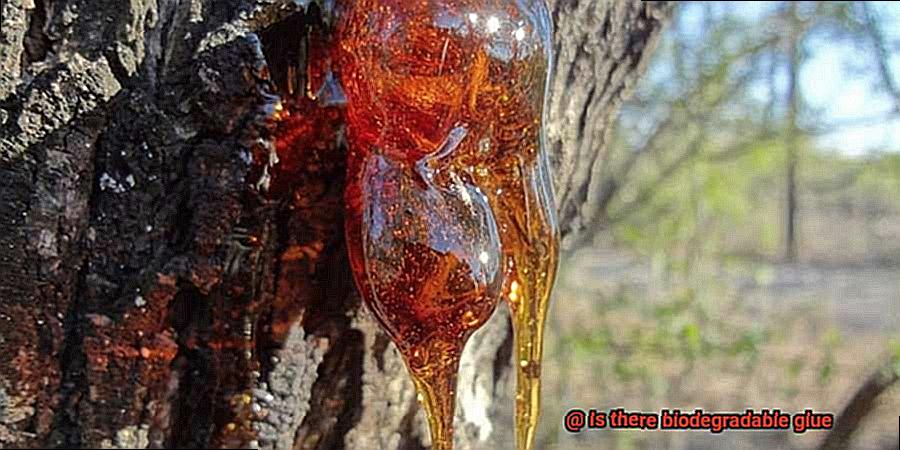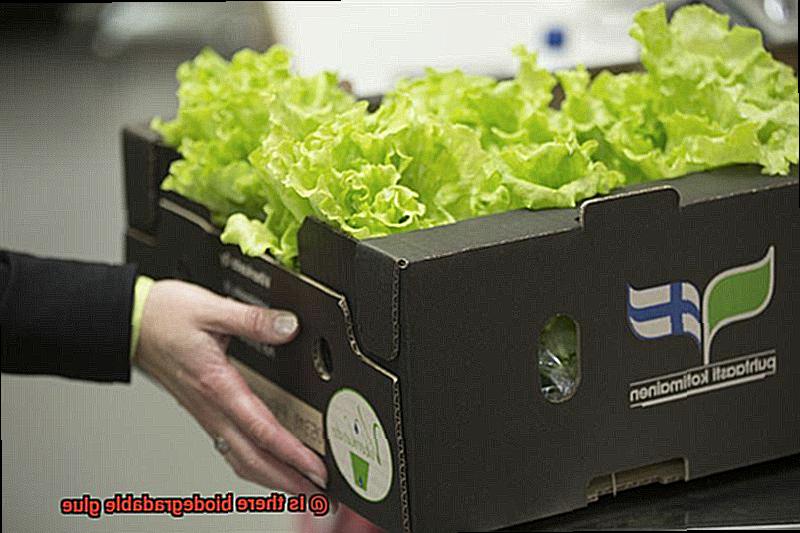Are you sick of sticky situations with glue that’s bad for the environment?
Worried about the damage non-biodegradable adhesives are causing to our planet? Well, fret no more.
The movement towards eco-friendly options is gaining steam, and that includes biodegradable glue. Yep, you heard it right – there’s a new wave of adhesive products that offer the same sticking power as traditional ones, but without the guilt trip.
So, buckle up and get ready to join us on this exciting journey through the land of sustainable stickiness.
The Problem with Traditional Glue
Contents
- 1 The Problem with Traditional Glue
- 2 Types of Biodegradable Glue
- 3 Applications of Biodegradable Glue
- 4 Performance and Durability of Biodegradable Glue
- 5 Factors Affecting Biodegradability
- 6 Certifications and Labels for Biodegradable Glue
- 7 Advantages and Benefits of Using Biodegradable Glue
- 8 Limitations and Challenges with Biodegradable Glue
- 9 Conclusion
Traditional glues have long been a staple in various industries, but their chemical composition, disposal challenges, limited versatility, and environmental impact have sparked concerns. In this article, we delve into the problems associated with traditional glue and explore the benefits of biodegradable glue as a sustainable alternative that addresses these issues.
Chemical Composition:
Traditional glues are often composed of petroleum-based chemicals like formaldehyde and volatile organic compounds (VOCs). These substances emit harmful fumes that endanger both human health and the environment. In contrast, biodegradable glues harness renewable resources, such as plant-based materials or natural polymers, making them safer and more eco-friendly.

Disposal Challenges:
Unlike biodegradable glues that break down naturally over time without leaving behind harmful residues, traditional glues are not biodegradable. Consequently, they accumulate in landfills, contributing to environmental pollution. Additionally, the production processes for traditional glues are energy-intensive and generate carbon emissions.
Limited Versatility:
Traditional glues create strong bonds that are notoriously difficult to break, making it challenging to separate or recycle bonded materials. For instance, glued paper cannot be easily recycled due to the interference of the glue in the recycling process. This results in a loss of valuable resources and hampers recycling efforts.
Environmental Impact:
The environmental impact of traditional glue is significant. From production to disposal methods, traditional glues contribute to pollution and carbon emissions. Furthermore, the solvents required for cleanup or removal of traditional glue can be toxic and pose risks to human health if mishandled.

The Solution: Biodegradable Glue:
Biodegradable glues offer a sustainable alternative to traditional adhesives. Made from renewable resources, these glues break down naturally over time into harmless substances. They are water-based and can be used in various applications, including packaging, woodworking, and even medical fields. Biodegradable glues provide a safer and healthier option for users while aligning with the sustainability goals of businesses and individuals.
Types of Biodegradable Glue
Glue is an essential tool in our everyday lives, used for everything from arts and crafts to construction projects. However, traditional glue made from synthetic materials can have a detrimental impact on the environment.
Luckily, there is a growing range of biodegradable glue options available that offer a sustainable alternative without sacrificing performance. In this article, we will delve into the fascinating world of biodegradable glue and explore the different types available on the market.
Natural Starch-Based Glues:

Derived from renewable resources such as corn or potato starch, natural starch-based glues are a popular choice for eco-conscious crafters. These water-based glues offer strong bonding power while being safe for both users and the environment.
Whether you’re working on a scrapbooking project or repairing a torn book spine, natural starch-based glues provide a sustainable solution that breaks down naturally over time.
Plant-Based Glues:
Harnessing the power of plants, plant-based glues are another fantastic option for those seeking biodegradable alternatives. Made from ingredients like soybeans or algae, these glues offer similar adhesive properties to traditional synthetic glues but with one major advantage—they break down more easily in the environment. From packaging to labeling, plant-based glues are commonly used in industries where temporary bonding is required.
Bio-Based Polymers:
Bio-based polymers, like poly lactic acid (PLA), are derived from renewable resources like corn or sugarcane. PLA glues have gained popularity due to their biodegradability and renewable sourcing. These adhesives provide excellent bonding strength and can be processed using conventional equipment. They find applications in packaging and disposable products, offering the perfect balance between functionality and environmental responsibility.
Compostable Glues:
Compostable glues are specifically designed to break down in composting facilities, making them ideal for industries like food packaging. These glues decompose alongside other organic materials, eliminating the need for separate disposal. Compostable glues ensure that packaging materials can fully decompose after use, reducing waste and promoting a circular economy.
Applications of Biodegradable Glue
Look no further than biodegradable glue, the eco-friendly solution for all your bonding needs. Whether you’re in the packaging, construction, textiles, automotive, medical, arts and crafts, or disposable product industry, biodegradable glue has got you covered.
In the packaging industry, biodegradable glue is a game-changer. It seals boxes, cartons, and envelopes securely while reducing environmental pollution. Say goodbye to harmful packaging waste and hello to a greener future.
Construction projects can also benefit from the power of biodegradable glue. It bonds materials like wood, paper, and cardboard while naturally decomposing over time. This means less harm to the environment and more sustainable building practices.
If you’re in the textile industry, biodegradable glue is a must-have. It’s perfect for fabric bonding, hemming, and seam sealing, especially in the production of eco-friendly clothing. Stay stylish and sustainable with biodegradable glue.
Automotive enthusiasts will be thrilled to know that biodegradable glue can be used for bonding different components of vehicles. From interior trims to exterior panels, this glue reduces pollution and keeps you on the road to a greener future.
In the medical field, biodegradable glue is a lifesaver. It can be used for wound closure and surgical procedures as an alternative to sutures or staples. With its gradual degradation within the body, there’s no need for removal after healing.
Artists and crafters rejoice. Biodegradable glue is perfect for all your creative projects. From scrapbooking to card making, this glue offers a safer and more environmentally friendly option without compromising on performance.
Last but not least, biodegradable glue is ideal for manufacturing disposable products such as paper cups, plates, and cutlery. By using this glue in their production, these items can be easily broken down and decomposed, reducing the impact on landfills.
Performance and Durability of Biodegradable Glue
These glues are designed to break down naturally over time, unlike their traditional counterparts that seem to stick around forever. But how do they perform? Let’s dive into the details.
Composition is a key factor in the performance and durability of biodegradable glues. Made from a variety of natural ingredients like plant-based resins or starches, these glues possess impressive bonding strength. However, they may have limitations when it comes to water or heat resistance. On the flip side, advanced technology has birthed biodegradable glues that mimic the performance of conventional ones, holding their own in tough conditions.
But it’s not just about what’s inside; how you use the glue matters too. Whether you’re applying it outdoors or in harsh environments, providing extra protection or reinforcement is crucial to maintaining its strength. Think of it like applying sunscreen before hitting the beach – your glue needs that same tender loving care.
Now, let’s talk about evaluating biodegradable glues. Testing and certification processes ensure that these glues meet specific requirements for different applications. Adhesive properties, shear strength, elongation, and more are carefully assessed, acting as a report card for glue. After all, nobody wants a failing grade.
It’s important to note that the degradation process of biodegradable glues can vary depending on environmental conditions. Some glues require specific moisture levels or exposure to certain microorganisms to break down effectively. So while these glues are designed to be environmentally friendly, it’s essential to consider how and where you use them.
In the battle between biodegradable glue and traditional synthetic glue, it ultimately boils down to your needs and environmental considerations. Biodegradable glues offer a greener alternative for specific applications, but it’s crucial to assess their performance characteristics before making a decision.
Factors Affecting Biodegradability
As an expert on the Factors Affecting Biodegradability, I am here to illuminate this captivating topic. Today, we embark on a journey into the secret life of glue, exploring the key factors that influence its biodegradability. So, fasten your seatbelts and prepare to unravel the mysteries of glue’s environmental fate.
Chemical Composition:
Let us commence our exploration with the foundation of glue – its chemical composition. Glues crafted from natural and organic materials, such as plant-based resins or starches, possess a higher likelihood of being biodegradable. Conversely, glues derived from synthetic or petroleum-based compounds may take longer to decompose. Thus, if you aspire to opt for an eco-friendly alternative, keep an eye out for glues bestowed by nature.
Bonding Strength:
Now, let us delve into the realm of bonding strength. We all desire our glue to firmly hold things together, do we not? Yet, did you know that stronger bonding properties can hinder biodegradability? Glues exhibiting weaker bonding strength tend to break down more easily, rendering them environmentally friendly. Consequently, when selecting glue, contemplate your requirements and strike a balance between strength and biodegradability.
Environmental Conditions:
Ah, the environment – where magic transpires. The conditions in which glue finds itself exposed wield immense influence over its biodegradability. Factors such as temperature, humidity, and microbial activity play pivotal roles here. Warm and moist conditions abundant with microbes can expedite degradation, while dry and cold conditions may decelerate it. Therefore, when employing or storing your glue, bear Mother Nature in mind.
Presence of Biodegradation Agents:
Microbes are the superheroes of biodegradation, yet they require the right tools to carry out their duties. Certain glues incorporate additives or ingredients that stimulate microbial growth and augment biodegradation. These additives encompass enzymes or other biological agents that aid in dismantling the glue’s chemical structure. Hence, with biodegradable glue, supporting these minuscule superheroes is paramount.
Application and Use:
Lastly, how you utilize your glue can influence its biodegradability. Outdoor applications expose glue to myriad environmental factors like sunlight and rain, hastening its degradation. Conversely, indoor applications may witness a slower biodegradation rate. Therefore, ponder the location and manner in which you intend to employ your glue when making your selection.
Certifications and Labels for Biodegradable Glue
Certifications and labels may not be the most thrilling aspect of glue shopping, but they hold immense importance when it comes to finding authentically biodegradable options. These little tags of credibility provide consumers with peace of mind, trustworthiness, consistency in standards, consideration for environmental impact, and assurance of regulatory compliance.
Firstly, certifications and labels offer consumers the assurance that the glue they are using will naturally break down over time. Without these certifications, it becomes challenging to determine if a product is genuinely biodegradable or if it will merely contribute to landfill waste. By seeking out certified options, consumers can make a conscious choice to minimize their environmental footprint.
Secondly, when a product carries a certification or label, it signifies that it has undergone rigorous testing and meets specific standards. This added credibility builds trust with consumers and demonstrates the manufacturer’s commitment to transparency and environmental responsibility. It ensures that the claims made by the manufacturer are backed by reliable evidence.
Moreover, certifications and labels provide a standardized way to compare products. With a wide range of glues available on the market, it can be overwhelming for consumers to navigate through all the options. Specific certifications such as BPI, EN 13432, or ASTM D6400 allow consumers to easily identify glues that meet recognized industry standards for biodegradability. This consistency in standards simplifies the decision-making process and empowers consumers to make informed choices.
Furthermore, choosing glue with certifications and labels allows consumers to actively contribute to reducing their environmental impact. Biodegradable glues break down into harmless substances, minimizing their negative effects on ecosystems and reducing waste in landfills. By consciously opting for certified products, consumers become part of the solution in preserving our planet’s health.
Lastly, some certifications and labels are mandatory by law in certain regions. The European Union’s EN 13432 certification, for example, is required for compostable products sold within the EU. By checking for these labels, consumers can ensure that they are purchasing glue that complies with local regulations and aligns with government initiatives.
Advantages and Benefits of Using Biodegradable Glue
Glue, a seemingly inconspicuous substance, has the potential to make a significant impact on the environment and our well-being. Enter biodegradable glue – the unsung hero of adhesives. In this article, we will delve into the captivating advantages and benefits of using biodegradable glue, exploring its positive environmental impact, versatility, safety features, and even its potential for improving brand image. Prepare to be amazed as we uncover the remarkable world of biodegradable glue.
Environmental Friendliness:
Traditional glues have an unfortunate fate of ending up in landfills, where they languish for centuries without decomposing. Biodegradable glue, however, is crafted from natural ingredients that break down over time, significantly reducing waste accumulation and pollution. With biodegradable glue, you can embrace a sustainable adhesive solution that aligns with your eco-conscious lifestyle.
Reduced Carbon Footprint:
Choosing biodegradable glue means actively contributing to the preservation of our planet. This innovative adhesive is often derived from renewable resources, such as plant-based materials. The manufacturing processes involved in creating biodegradable glue require less energy and generate fewer greenhouse gas emissions compared to traditional glues. By opting for biodegradable glue, you are helping to lower your carbon footprint and pave the way for a greener future.
Health and Safety:
Biodegradable glue provides a safer alternative for both users and the environment. Traditional glues may contain harmful chemicals that release fumes, leading to respiratory issues and allergic reactions. In contrast, biodegradable glue eliminates these concerns entirely by utilizing non-toxic ingredients. Say goodbye to worries about chemical exposure and breathe easy with this healthier adhesive choice.
Versatility:
Biodegradable glue is a true chameleon in the world of adhesives. Whether you’re a crafting enthusiast, a woodworking aficionado, or in need of adhesive for medical purposes like wound care or surgical procedures, biodegradable glue has you covered. Its versatility knows no bounds, making it the go-to adhesive for a vast array of applications.
Biocompatibility:
In situations where glue comes into direct contact with living organisms, such as in the medical or cosmetic industry, biodegradable glue offers a remarkable advantage – biocompatibility. Derived from natural sources, this adhesive is gentle on the skin and less likely to cause adverse reactions or harm living tissues. With biodegradable glue, you can confidently use products that prioritize your well-being.
Positive Brand Image:
In our increasingly eco-conscious world, using biodegradable glue can help businesses enhance their brand image and reputation. By showcasing a commitment to sustainability and environmental responsibility, companies can attract consumers who prioritize sustainable products. Embracing biodegradable glue demonstrates a dedication to reducing environmental impact and resonates with individuals seeking eco-friendly practices.
Limitations and Challenges with Biodegradable Glue
Biodegradable glue, heralded as a sustainable alternative to traditional adhesives, holds tremendous promise in reducing environmental impact. However, it is crucial to acknowledge the limitations and challenges that accompany this eco-friendly solution. In this article, we will delve into the complexities surrounding strength and durability, shelf life, cost, disposal methods, availability, and regulatory standards to gain a deeper understanding of biodegradable glue’s potential.
Strength and Durability:
A concern often raised regarding biodegradable glue is its ability to match the strength and durability of synthetic adhesives. Derived from natural materials like plant-based polymers or starch, biodegradable glues may not possess the same adhesive properties as their synthetic counterparts. Consequently, bonding certain materials or withstanding heavy loads can pose a challenge for biodegradable glue. However, ongoing research and development endeavors aim to enhance its adhesive capabilities without compromising its eco-friendly attributes.
Shelf Life:
The organic composition of biodegradable glues can result in a shorter lifespan compared to conventional adhesives. This limitation poses difficulties in industries that demand long-lasting adhesive solutions such as construction or automotive. Nonetheless, scientists are tirelessly working to extend the shelf life of biodegradable glues through innovative formulations and preservation techniques. Balancing sustainability with longevity is key to unlocking their full potential.
Cost:
The production process of biodegradable glue, utilizing sustainable materials, can often be more expensive than traditional methods. While this higher cost may limit accessibility for smaller businesses or budget-conscious individuals, it ultimately reflects the true value of preserving our planet. As demand continues to rise and production scales up, economies of scale are expected to gradually reduce the cost of biodegradable glue, making it more accessible to a wider audience.
Disposal Methods:
Proper disposal of biodegradable glue is critical to ensuring its environmental benefits. Although designed to naturally break down over time, incorrect disposal methods can still cause harm. Adhering to guidelines for composting or recycling is essential to prevent the inadvertent contamination of landfills or bodies of water. By embracing responsible disposal practices, we can fully harness the eco-friendly nature of biodegradable glue.
Availability:
While interest in eco-friendly adhesives is rapidly growing, the variety and availability of biodegradable glues on the market remain somewhat limited. This poses a challenge for consumers and industries seeking specific adhesive properties for their applications. However, as awareness and demand increase, it is expected that more options will emerge, offering tailored solutions to diverse adhesive needs.
v4cdfWPCi8o” >
Also Read: Is Elmer’s Glue Eco-Friendly?
Conclusion
In conclusion, the quest for biodegradable glue has gained significant attention in recent years. While traditional glues are often made from non-biodegradable materials that contribute to environmental pollution, researchers and manufacturers have been working diligently to develop alternatives that break down naturally over time. These innovative solutions aim to reduce the ecological impact of adhesive products while still maintaining their functionality and effectiveness.
One promising option is plant-based glue, which utilizes natural ingredients derived from renewable resources such as corn or soybeans. These bio-based adhesives not only offer comparable performance to their non-biodegradable counterparts but also decompose more easily, minimizing their long-term environmental footprint.
Another avenue being explored is the use of microbial or enzymatic glues. These cutting-edge formulations harness the power of microorganisms or enzymes to create adhesive bonds that can be broken down by natural processes. This approach shows great potential for industries where temporary bonding is required, as it offers a sustainable alternative to conventional glues that often end up in landfills or water bodies.
Furthermore, advancements in nanotechnology have opened up new possibilities for biodegradable adhesives. Nanoparticles can be incorporated into glue formulations to enhance their strength and durability while still allowing them to degrade when exposed to specific environmental conditions. This exciting development paves the way for even more environmentally friendly adhesive options in the future.
In conclusion, while there may not yet be a perfect solution, the ongoing efforts towards developing biodegradable glues are commendable. As consumers become increasingly conscious of their environmental impact, demand for eco-friendly alternatives will continue to grow. By investing in research and innovation, we can hope to see a future where biodegradable glues are readily available and widely adopted across various industries.






